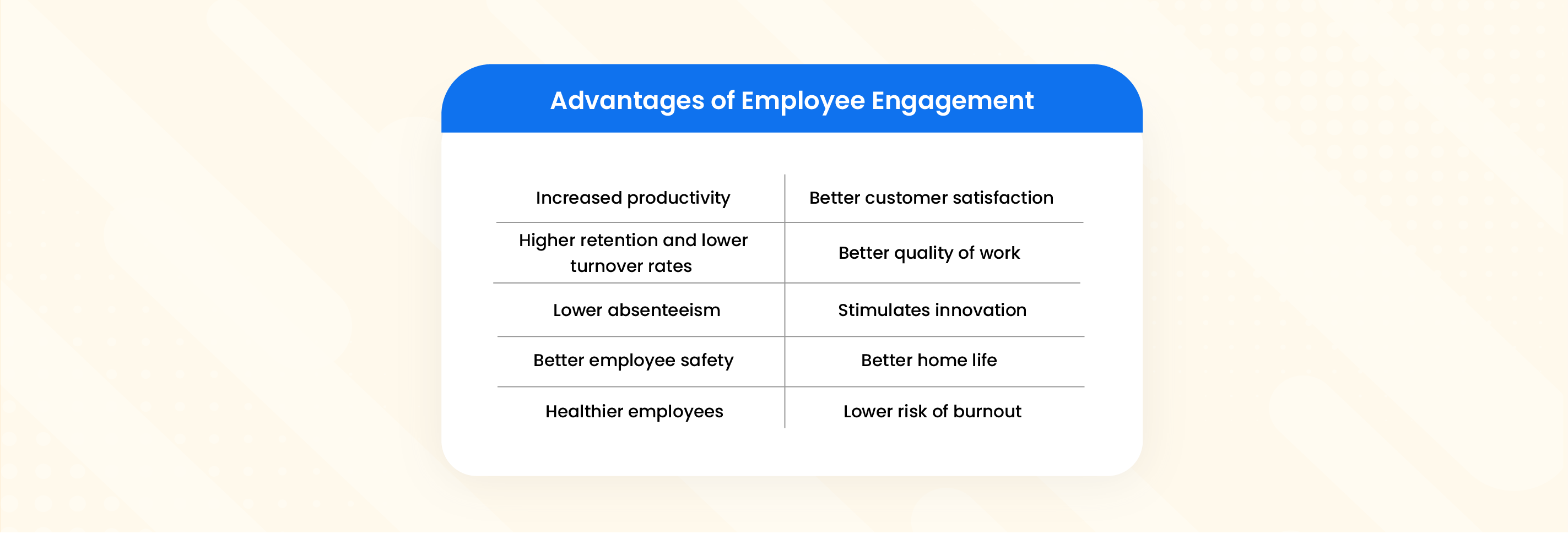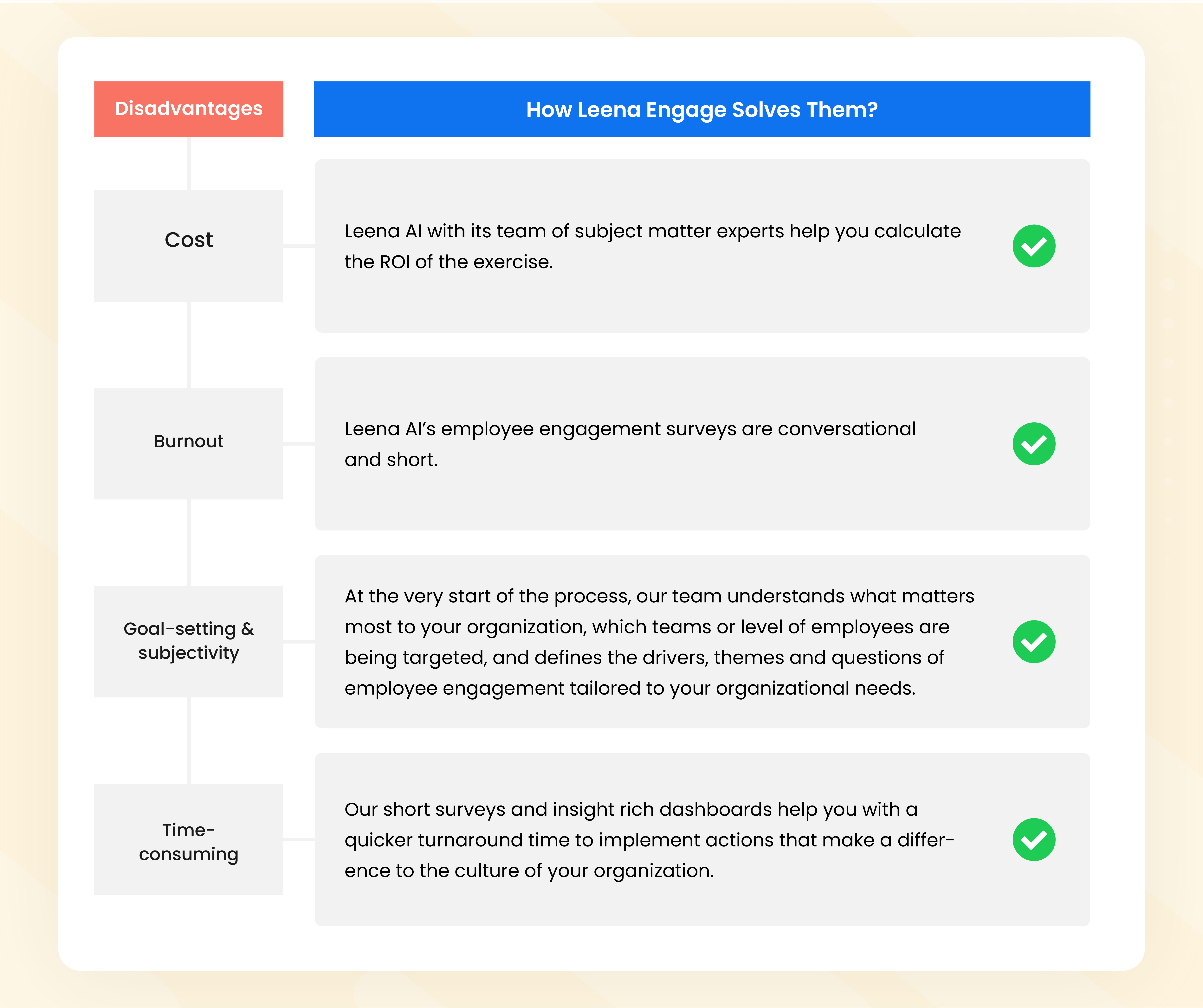Employee engagement has been a trending word in the HR industry. Numerous businesses have started focusing on building an engaged workforce to improve performance, drive more sales, and ultimately grow their top-line. Employee engagement has become a crucial parameter of organizational success, with employers proactively taking extensive measures towards it.
So what really is the importance of employee engagement in the workplace? What are the benefits of employee engagement? What are the advantages of employee engagement?
This blog post will answer some of these questions around the advantages and disadvantages of employee engagement. Let’s dive right in!
What Are the Advantages of Employee Engagement?

Employee engagement is the key to building a successful business these days. In today’s fast-changing business environment, its importance has increased manifold.
Below are some compelling benefits of employee engagement that may help your organization:
One of the most important advantages of employee engagement is increased productivity. Employee productivity is crucial for any business. The more productive your employees are, the more likely your business will succeed. Employers try different strategies to increase employee productivity — from offering learning opportunities to rewarding employees based on their performance. But, they’re missing the most critical solution: employee engagement.
Engaged employees have a positive attitude towards their organization as they strongly believe in the company’s mission and vision. This makes them like what they do and find their work meaningful. Plus, such employees work harder and with more enthusiasm to proactively reach their goals.
One of the biggest advantages of employee engagement is a sense of belonging and commitment to the organization. As a chain reaction, engaged employees are less absent, more productive, motivated, and generally more invested in their work. They are less likely to wander off and look for new opportunities as they are happy and engaged in their current role.
Engaged employees look for growth opportunities within the organization, actively contribute to the organization, and are committed to it for the long-run. Employee engagement ensures that employees feel fulfilled in their work and look forward to a long-term association, bringing down turnover rates. As long as an organization keeps their employees engaged, retention rate is likely to increase as they are less likely to find any reason to search for opportunities elsewhere.
High turnover rates due to disengagement at work have significant cost implications for organizations and have a direct bearing on organizational productivity and performance. Hiring is an expensive affair, add to that the time and resources spent to screen, interview, onboard, and train a new employee to their full potential.
The guaranteed benefits of employee engagement include loyalty and commitment to the organization, which in turn result in lower attrition.

Engaged employees enjoy their work, peers, and workplace and thus don’t take frequent leaves, lowering absenteeism. Higher absenteeism can put undue pressure on an employee’s peers and managers, in order to streamline work, straining their relationship. One of the major importance of employee engagement in the workplace is its impact on lowering absenteeism and creating a better work culture.
One of the benefits of employee engagement is that engaged employees are invested in their work, care about the company’s success, and hence happily show up to work.

Engaged employees are more connected to their organizations and have a greater commitment to quality and safety at work. Engaged employees tend to focus their attention on following the best practices and guidelines to be more effective in their work, making lesser mistakes, and ultimately making the organization a safer place. Incidents of mental or verbal abuse or physical accidents or mishaps are less likely to happen when an organization has high employee engagement levels.

Many organizations believe that operating in a high-stress environment is the most effective way to motivate employees to perform their best. The idea that co-workers are the competitors and not colleagues are expected to keep them engaged and productive. However, this type of system in the workplace can reduce their productivity over time and, most importantly, increase mental health-related issues among workers.
Engaged workplaces respect the employee’s goals and needs, encouraging them to take care of their health and well-being. They offer numerous benefits like flexible schedules, mental health workshops, healthy snacks, and paid time off (PTOs) to not only address stress-induced issues but also to make them feel appreciated, valued, and ultimately healthy. Healthy employees mean a healthy organization.

No matter how modern or tech-enabled an organization is, providing top-notch customer service should always be one of the top priorities. It makes the customers feel valued, which can go a long way in building strong customer relationships.
Engaged employees are happy and deeply care about their jobs. Their engagement reflects in their attitude and how they strive hard to create a positive customer experience. The joy they derive from their work reflects in their dealings with customers.
Such employees are likely to make more sales and revenue, drive higher returns on customer success management, and always put the company’s best face forward.

When employees are engaged, they perform their best in every task. They are much more motivated than others and work with full dedication and precision. Plus, they are less likely to make mistakes and achieve higher excellence.
Engaged employees also enjoy their work and are more efficient as compared to disengaged workers. They constantly come up with innovative employee engagement ideas, learn from managers and leaders, participate in group discussions, and work in teams. Further, they work to upskill themselves by taking courses, attending seminars, and more.

Encouraging employees to be innovative, creative, and share their ideas is another fantastic way to build an engaged workforce.
Zealous employees perform their best when they are fully engaged in their work. They continuously develop new, innovative ideas which can help boost the company’s reputation. Further, when they get the opportunity to invest time in innovation, it makes them feel accomplished and valued, which, in turn, provides higher value for the business. This can also save tons of time and resources as employees might come up with dynamic ideas without resorting to external sources. Even employers implement various employee engagement strategies that stimulate innovation within their employees.
In short, companies that encourage employees to be innovative have a stronger and more loyal workforce. And it also provides employees the autonomy to make decisions and produce creative work.

Employees who are engaged at work have happier and more satisfying home lives. When employees work in a positive environment that supports their ideas, provides opportunities to grow, and network with peers and leaders, they are more likely to have better moods. Further, they share those experiences with their family and become more effective and satisfied in the home environment.
In other words, engaged workers are crucial not just for the organization but also for their families. Happier employees don’t complain about their day-to-day job happenings to their family members, have the energy to spend time with their spouse and kids, and ultimately contribute to a positive home atmosphere.

No organization wants to hire a candidate only to lose them to burnout. And this isn’t an overnight problem; burnout can take days, weeks, months, or even years to show. Once an employee starts experiencing this, they can suffer from symptoms like severe physical and emotional fatigue, lack of interest in work, feeling of incompetence, and more.
One of the significant causes of burnout can be the lack of employee engagement practices. Disengaged employees aren’t happy to go to work and feel less excited about their job. On the other hand, employees who are happy, engaged, and motivated at the workplace understand that their skills and talents are required by the organization, which helps them keep their emotional and physical energies up while performing tasks.
What Are the Disadvantages of Employee Engagement?

Employee engagement requires earnest efforts from the organization. Some disadvantages of employee engagement are as follows:
- Cost: Training procedures and the purchase of new platform/software can be an added expense if your organization is just starting.
- Burnout: Survey burnout is possible and thus enough thought needs to go into the goal, definition, drivers, frequency, and number of questions to make an employee engagement plan count. Employee engagement activities and strategies need to be paced out to avoid burnout and to gauge its outcome.
- Goal-setting: Employee engagement strategies implemented only to follow the status quo and without a purpose can lead to increased expense and zero impact. Therefore, a strategically designed and data-backed approach is a must for employee engagement to exhibit positive results. With the future of work becoming a reality, the purpose of employee engagement is getting redefined. It is important for organizations to define where they fit in the future of work and approach employee engagement accordingly.
- Time-consuming: One employee engagement initiative cannot increase productivity overnight. It needs time, data analysis, regular supervision, and repetition of efforts.
- Subjectivity: From generational research, it has been found that attitudes and expectations about the role of work and company loyalty differ dramatically between generations. Organizations need to know what segment of their workplace are their employee engagement initiatives targeted towards or design them in a way that caters to everyone.
- Unreliable responses: Employees might share responses that are aimed only to please their managers. In the case of anonymous surveys, they might take out personal grudges against a co-worker and can damage their performance report. It is important for organizations to create a conducive environment for employees to be able to actually contribute to the process. When employees see positive changes in the workplace, they are more likely to trust the process and provide and support it with insightful feedback.
Bottom Line – Should You Focus On It or Not?

Employee engagement is all about how you make your employees feel in your company. And only HR professionals can bridge the gap between employee engagement and disengagement. However, there’s no doubt that it’s a tough job and requires serious commitment from the organization. But, with the right HR tools, companies can eliminate its adverse effects effectively.
For example, artificial intelligence-based HR tools can streamline employee data, simplify workflows, and keep you and your employees up-to-date with the latest tools and technologies. Moreover, it ensures that the data remains secure and in control of the organization.
Here’s how Leena Engage can help you amplify the advantages of employee engagement:

Looking for an AI-powered HR tool to make the job easy for you? Try Leena AI.








